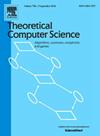完美图子类上的跳支配
IF 1
4区 计算机科学
Q3 COMPUTER SCIENCE, THEORY & METHODS
引用次数: 0
摘要
如果每个顶点u∈V(G)∈S,且存在一个顶点V∈S,使得d(u, V)=2,其中d(u, V)表示G中u与V之间的距离,则集S是一个跳控制集,给定一个图G,跳控制要求求出G的一个跳控制集的最小大小,也称为跳控制数。Henning等人(Graphs combination . 2017)表明,对于二部图和弦图,Hop Domination是NP-hard的。由于弦图类包含在完美图类中,所以问题在完美图上是np困难的。我们希望研究完美图子类上问题的复杂性,并了解问题的复杂性在哪里从易处理转变为难以处理。以下是本文的研究结果。给出了置换图、区间图和双凸二部图上Hop支配的多项式算法。推广了二部置换图上Hop支配的多项式时间算法。我们还从参数化复杂性的角度对这一问题进行了研究。我们证明了当解的大小参数化时,跳支配的决策版本是W[2]-hard。本文章由计算机程序翻译,如有差异,请以英文原文为准。
Hop domination on subclasses of perfect graphs
A set is said to be a hop dominating set if every vertex , there exists a vertex such that where represents the distance between and in . Given a graph , Hop Domination asks to find the minimum size of a hop dominating set of , also called the hop domination number. Henning et al. (Graphs Combin. 2017) showed that Hop Domination is NP-hard for bipartite graphs and chordal graphs. Since the class of chordal graphs is contained in the class of perfect graphs, the problem is NP-hard on perfect graphs. We would like to study the complexity of the problem on subclasses of perfect graphs and understand where the complexity of the problem shifts from tractable to intractable.
The following are the results of this paper. We present polynomial algorithms for Hop Domination on permutation graphs, interval graphs and biconvex bipartite graphs. This generalizes the polynomial time algorithm for Hop Domination on bipartite permutation graphs. We also initiate a study on this problem from the parameterized complexity perspective. We show that the decision version of Hop Domination is -hard when parameterized by solution size.
求助全文
通过发布文献求助,成功后即可免费获取论文全文。
去求助
来源期刊

Theoretical Computer Science
工程技术-计算机:理论方法
CiteScore
2.60
自引率
18.20%
发文量
471
审稿时长
12.6 months
期刊介绍:
Theoretical Computer Science is mathematical and abstract in spirit, but it derives its motivation from practical and everyday computation. Its aim is to understand the nature of computation and, as a consequence of this understanding, provide more efficient methodologies. All papers introducing or studying mathematical, logic and formal concepts and methods are welcome, provided that their motivation is clearly drawn from the field of computing.
 求助内容:
求助内容: 应助结果提醒方式:
应助结果提醒方式:


